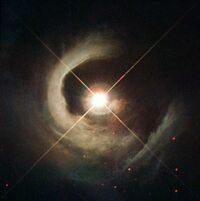Astronomy:V1331 Cygni
Coordinates: ![]() 21h 01m 9.21s, +50° 21′ 44.77″
21h 01m 9.21s, +50° 21′ 44.77″
| Observation data Equinox J2000.0]] (ICRS) | |
|---|---|
| Constellation | Cygnus |
| Right ascension | 21h 01m 09.20684s[1] |
| Declination | +50° 21′ 44.8033″[1] |
| Apparent magnitude (V) | 11.99[2] |
| Characteristics | |
| Astrometry | |
| Proper motion (μ) | RA: 0.980[1] mas/yr Dec.: −3.783[1] mas/yr |
| Parallax (π) | 1.6760 ± 0.0237[1] mas |
| Distance | 1,950 ± 30 ly (597 ± 8 pc) |
| Details[3] | |
| Mass | 2.8 M☉ |
| Radius | 5 R☉ |
| Temperature | 5200 K |
| Other designations | |
V1331 Cyg, GSC 03596-00959, 2MASS J21010920+5021445 | |
| Database references | |
| SIMBAD | data |
V1331 Cygni (also known as V1331 Cyg) is a young star in the constellation Cygnus. V1331 Cyg is located in the dark nebula LDN 981.[4]
V1331 Cygni is most noted for having an arc-like reflection nebula surrounding it. This circumstellar disc is a great birthplace for young stars, which form in the cloud.[5] V1331 Cygni is heavily obscured by dust, so the properties of the central star are hard to deduce; however, it is estimated to have a radius five times that of the Sun and a mass of 2.8 M☉.[3]

The General Catalog of Variable Stars classifies V1331 Cygni as an "INST" type variable, meaning a T Tauri star which shows rapid light variations.[7][8] Its visual band brightness varies from magnitude 13.08 to 10.58.[7] It is sometimes classified as a pre-FUOR star.[9] A semi-regular period of ~449 days has been reported.[9] Unlike many T Tauri stars, the mean brightness of V1331 Cygni remains nearly constant over long time periods.[10][6]
Gallery
Dark nebula LDN 981 and V1331 Cygni (top center) by the Mount Lemmon SkyCenter
References
- ↑ 1.0 1.1 1.2 1.3 1.4 Brown, A. G. A. (August 2018). "Gaia Data Release 2: Summary of the contents and survey properties". Astronomy & Astrophysics 616: A1. doi:10.1051/0004-6361/201833051. Bibcode: 2018A&A...616A...1G. Gaia DR2 record for this source at VizieR.
- ↑ Zacharias, N. (2012). "The fourth US Naval Observatory CCD Astrograph Catalog (UCAC4)". VizieR On-line Data Catalog. Bibcode: 2012yCat.1322....0Z.
- ↑ 3.0 3.1 Cite error: Invalid
<ref>tag; no text was provided for refs namedPetrov - ↑ "A young star takes centre stage". https://www.spacetelescope.org/images/potw1509a/. Retrieved 10 May 2019.
- ↑ Choudhary, A.; Stecklum, B.; Linz, Hendrik (2016). "Hubble imaging of V1331 Cygni: proper motion study of its circumstellar structures". Astronomy & Astrophysics 590: A106. doi:10.1051/0004-6361/201527547. Bibcode: 2016A&A...590A.106C.
- ↑ 6.0 6.1 Mel'nikov, S. Yu. (1997). "Quasi-periodic light variations in four Herbig Ae/Be stars". Pis'ma Astron. Zh 23 (6): 799–810. Bibcode: 1997AstL...23..799M. https://adsabs.harvard.edu/pdf/1997AstL...23..799M. Retrieved 27 December 2021.
- ↑ 7.0 7.1 "V1331 Cyg". AAVSO. https://www.aavso.org/vsx/index.php?view=detail.top&oid=12251.
- ↑ GCVSTypes. "GCVS Variability Types". Sternberg Astronomical Institute. http://www.sai.msu.su/gcvs/gcvs/vartype.htm.
- ↑ 9.0 9.1 Hamilton, Joshua R. (June 2021). "Light Curve Analysis of 185 YSOs: New Periods Discovered for 9 Stars". JAAVSO 49 (1): 49–57. Bibcode: 2021JAVSO..49...49H. https://ui.adsabs.harvard.edu/abs/2021JAVSO..49...49H. Retrieved 22 December 2021.
- ↑ Ismailov, N. Z. (April 2005). "A new classification scheme for T Tauri light curves". Astronomy Reports 49 (4): 309–315. doi:10.1134/1.1898408. Bibcode: 2005ARep...49..309I. https://link.springer.com/article/10.1134%2F1.1898408. Retrieved 22 December 2021.
 |



